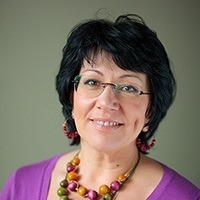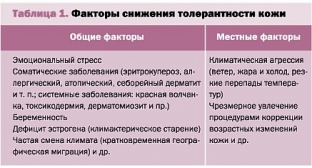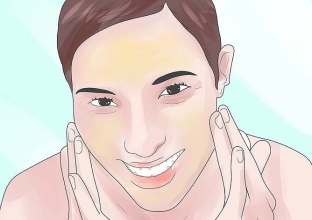Hypersensitive skin not only requires special care, but also a special approach from a beautician in the fight against skin aging. Therefore, Estet-portal decided to find out what needs to be done and how. What is the first thing a doctor should pay attention to when working with hypersensitive skin? Which peel is best for hypersensitive skin? How can the reaction of the skin to the irritant action of acids be softened?
 These difficult questions were answered by Svetlana Kovaleva, dermatologist, cosmetologist, certified trainer of Filorga Laboratories (France), Moscow.
These difficult questions were answered by Svetlana Kovaleva, dermatologist, cosmetologist, certified trainer of Filorga Laboratories (France), Moscow.
Hypersensitivity, according to most researchers, is not a stable skin condition and does not determine its type. This problem can occur with both dry and oily and combination skin types. According to various surveys, increased skin sensitivity is characteristic of an average of 60% of the adult population in Europe, the USA and Japan. The scientific community has not yet formed a final opinion on the classification of hypersensitivity, and there is no clear definition of the concept itself.
The most characteristic symptoms of this skin condition are:
- objective - erythema, desquamation, pastosity, rash;
- subjective - itching, tightness and tingling sensation.
One or more of the listed symptoms, which appear as an inadequate response to external stimuli and / or internal imbalance against the background of reduced skin barrier functions, are the main diagnostic criteria. In addition, it should be remembered that facial erythema may be a manifestation of diseases such as systemic lupus erythematosus, toxicoderma, dermatomyositis, etc.
With a complex clinical picture of long-term erythema, when clear cause-and-effect relationships are not revealed, differential diagnosis is necessary. In such cases, it is worth delaying the use of cosmetic procedures until a final diagnosis is made.
New strategy
In recent years, the fundamental principles of aesthetic medicine have changed, dictating new rules for managing patients, especially those with difficulties with tolerability of procedures.
1. Procedures must be comprehensive. Today, a doctor working in aesthetic medicine seeks to combine synergistic methods in one procedural protocol, and not to use monotherapy or different methods of correction in stages, based only on the absence of antagonism of their actions. It is synergism as a principle that underlies the combination of certain anti-age procedures.
2. A global correction strategy, not a targeted elimination of a single skin defect. The physician must have a forward-looking plan of action for a wide area of influence and be able to explain his strategy to the patient. The patient's compliance is now placed on a par with other important factors in the effectiveness of therapy.
Z. Individualization of the method of correction, and not universality, which was common until recently, mainly due to the limited range of procedures. The point is that there is no and cannot be a universal method suitable for any patient. Today, when choosing a method, it is necessary to proceed from the adequacy of its action in relation to the specific problem of a particular patient. Guaranteed safety and the most gentle effect are mandatory, excluding hypercorrection and the need for a long period of skin rehabilitation. Thus, the main rule is to follow the principle of "best possible".
Peeling as a central element of anti-age correction of intolerant skin
The presence of hypersensitive skin in a patient first of all requires preliminary correction of an acute condition and especially delicate care. In modern cosmetology, the basic (basic) care for hypersensitive skin is understood as gentle cleansing, adequate hydration and photoprotection. But how to deal with the signs of aging of such skin? On the one hand, today the range of skin rejuvenating drugs and methods available to cosmetologists is quite wide. But, on the other hand, hypersensitivity, unfortunately, is a contraindication to the use of most of them due to the unpredictable skin response to the applied effect (active substance) and difficult period of rehabilitation. In addition, it is often the procedures aimed at correcting various manifestations of skin aging that provoke further even more pronounced intolerance. Thus, the range of possible anti-age procedures is sharply narrowed.

When working with hypersensitive skin, the focus of the cosmetologist should be on the following tasks: relief of neurogenic inflammation and oxidative stress, reduction of tissue hypoxia, increase in skin barrier functions and minimization of moisture loss, normalization of microcirculation. Without solving these problems, the correction of age-related changes in hypersensitive skin will not give the desired result, since any impact is likely to cause a negative response.

For several decades, chemical peeling has been the main method of skin renewal, successfully solving the following tasks:
- reduction in the thickness of the stratum corneum,
- improvement of the structural organization of the dermis fibers,
- increasing skin hydration,
- decreased TEWL.
In combination of actions, chemical peeling optimizes the barrier properties of the skin and increases the effectiveness of the entire complex of subsequent stages of correction. Obviously, its effects satisfy many of the needs of intolerant skin. Therefore, it is no coincidence that both doctors and manufacturers of cosmetic products consider peeling as the basis of an integrated approach to rejuvenating correction of such skin. Until recently, the challenge was how to deal with skin hypersensitivity to acids.
One of the directions in solving this problem is the modification of the composition of the drug. This is how new polysaturated peels were created. Their main component is 20% and 50% glycolic acid. This -hydroxy acid was chosen as having the mildest effect on the skin. It is characterized by the absence of systemic complications and undesirable local consequences (erythema, desquamation), has a pronounced antioxidant and anti-inflammatory effect.
Also important (bearing in mind the multicomponent composition) is the ability of glycolic acid, due to its low molecular weight, to play the role of an enhancer for other active ingredients combined with it. At the same time, 20% and 50% concentrations are sufficient for active exfoliation and subsequent skin regeneration. A 20% solution is recommended for the initial treatment in patients with hypersensitive skin. In the future, it is possible to increase the peeling exposure time from 2 to 5 minutes and then, by the 3rd-4th course procedure, switch to a 50% solution.
In addition to glycolic acid, solutions for the preparatory, main and final stages of peeling contain 17 more ingredients: glycyrrhizic acid, glycine, extracts of white mulberry, brown algae, chamomile, witch hazel, arbutin, vitamins A, C, E, lipoamino acid, D -panthenol, allantoin, fructose, glycerin, niacinamide, kojic acid and urea.
One group of components is responsible for the immediate effect - these are antioxidants, anti-inflammatory and moisturizing plant complexes. Another group regulates the processes of melanogenesis, corrects involutional changes. The effect of their application is of a prolonged cumulative nature. It is the presence of substances that regulate melanogenesis and reduce photosensitivity that ensures the off-season of peeling. These are kojic acid, arbutin, niacinamide and vitamin C. They not only inhibit the activity of tyrosinase, causing inhibition of the oxidation of DOPA to DOPAmin, but also regulate the transport of the pigment by melanosomes.
Polysaturated peels are indicated for various manifestations of chrono- and photoaging of intolerant skin. In addition, they are recommended at the stage of preparing sensitive skin for a mesotherapy session and immediately before it. In this case, to perform a complex meso-peeling procedure that combines mesotherapy with preliminary exfoliation, a 50% glycol peel is indicated. The recommended course is 4-8 procedures with an interval of 7-10 days, 2 times a year; single use possible.

Synergism of effects: cryotherapy and peeling
Given the need of hypersensitive skin to activate cellular respiration and normalize microcirculation, we consider it expedient to combine peeling with methods that, among other positive effects, provide oxygenation. As practice has shown, good results are obtained by apparatus cryotherapy using Peltier elements as a source of stable low temperatures.
Low temperature leads to vasoconstriction of the vessels of the microcirculatory bed - a physiological reaction aimed at maintaining thermoregulation. A stable and uniform effect of cold during the procedure, due to the release of mediator molecules, causes a cyclical alternation of vasoconstriction and vasodilation processes. This reaction, which is called the paradoxical vasomotor reaction, is extremely important in aesthetic procedures. It changes the permeability of the skin to biomimetic components from the composition of cosmeceuticals and facilitates their penetration into the skin. The phenomenon of paradoxical vasomotor reaction activates microcirculation in the skin and contributes to greater saturation of dermal cells with oxygen. Cells that receive sufficient oxygen
Thus, not only more active ingredients penetrate into the skin, but their action on the cells of the dermis also becomes more active. Even without the use of cosmeceuticals, the improvement in the condition of sensitive skin during a cryotherapy session, due to the normalization of microcirculation, is obvious.Another important effect when working with intolerant skin is analgesic: the effect of cold suppresses the sensitivity of skin pain receptors and prevents the transmission of pain impulses to the central nervous system. Due to this, subjective negative sensations (discomfort) during a peeling session are leveled.
According to COSMETIC International








Add a comment